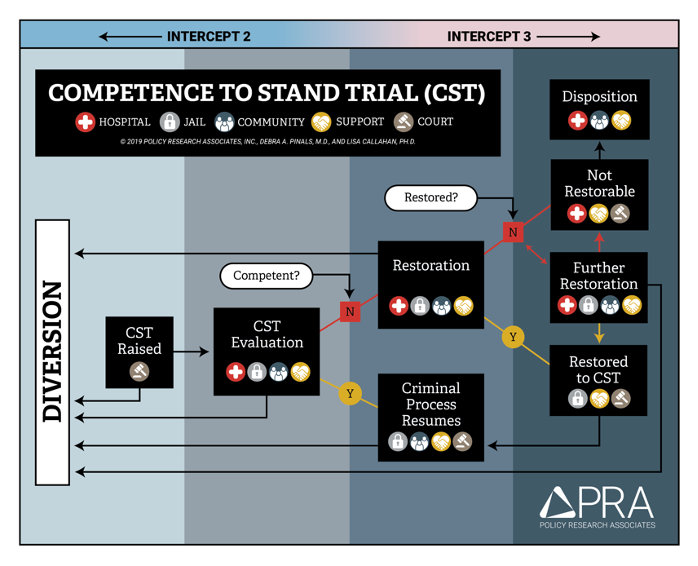
Competence to Stand Trial Mappings

Competence to Stand Trial Mappings
What’s
at Stake
Costly, long stays
in psychiatric
hospitals or jails
Courts can raise concerns around a person’s competence to stand trial (CST) during the trial process. They do this when individuals exhibit signs of conditions that can impair their ability to understand the charges brought against them and assist their attorney in preparing their defense. The signs and symptoms of such conditions vary. The conditions can include serious mental illness, intellectual and developmental disabilities, or disorders affecting neurocognition and behavior. When these concerns arise, the court can order a competence examination requiring forensic evaluation and systems. Often it is a lengthy and expensive process.
Individuals that may require CST evaluation are rarely considered for diversion, though they tend to be ideal candidates for community-based services. Instead, they become detainees for long periods in jails or state psychiatric hospitals while waiting for an evaluation. This can have harmful results. Potential negative outcomes include reentry into the forensic or criminal justice system—a misuse of resources. This misallocation has overburdened the mental health system in many places and has been the subject of class-action lawsuits brought against states.
Our Solution
At every point in the CST process, there is a gatekeeper who has the ability to divert an individual to community-based treatment. But the different parts of the CST system are often poorly connected. This prevents gatekeepers from seeing the bigger picture and coordinating with one another. The Competence to Stand Trial Mapping catalyzes these needed connections. It helps communities identify decision-makers, critical stakeholders, and programs within the CST/competence restoration (CR) system. Systems Mapping Center facilitators work with communities to identify these people and resources and incorporate them into a map. This map helps stakeholders see duplication and gaps.
Working together, Systems Mapping Center facilitators can help communities improve their CST processes. The mapping process aims to implement solutions to decrease waitlists and shorten a defendant’s length of stay in a hospital or jail setting. Strategies could include, but are not limited to:
- Establishing bail considerations to allow for release with support
- Ensuring rapid access to brief clinical or forensic evaluations
- Installing screening protocols to determine the needed level of care
- Training forensic evaluators on potential community-based services to identify alternatives to traditional inpatient restoration
- Creating positions for forensic navigators who can provide support to people in the competence system and share information with stakeholders on potential diversion programs
Our Model
The Competence to Stand Trial flowchart focuses on Intercepts 2 (Initial Detention/Initial Court Hearings) and 3 (Jails/Courts) of the Sequential Intercept Model. These are key decision points in the CST process. They provide an opportunity for justice and behavioral health professionals to consider and create unique diversion opportunities.
CST is typically raised after arraignment and before case adjudication and sentencing. Intercepts 2 and 3 offer a broad range of diversion opportunities for individuals for whom CST is raised and those who have been ruled incompetent to stand trial (IST) with the potential for restoration. They even present opportunities to divert those found not restorable.
The Competence to Stand Trial flowchart outlines a series of common decision points within the CST process. Some examples of these events are evaluation, restoration, and disposition. Each decision point highlights possible outcomes and places where individuals could be referred. These include hospitals, jails, community-based treatment services, supportive services, and courts.

Stakeholders
The stakeholders involved in the Competence to Stand Trial Mapping include the following:
- Advocates
- Behavioral health providers
- Community-based services
- Courtroom and legal professionals
- Families of individuals for whom CST has been raised
- Forensic evaluators
- Healthcare providers
- Jail staff
- Law enforcement
- People with lived experience
Case Studies
Over the past 10 years, Policy Research Associates has collaborated with states to reimagine their CST/CR systems. Many different vehicles have enabled this effort. Policy Research has worked with different localities through SAMHSA’s GAINS Center’s Criminal Justice Communities of Practice, the Trueblood settlement in Washington State, and other fee-for-service activities.
Highlights From the Criminal Justice Communities of Practice
- California has implemented a forensic mental health diversion program in 24 counties.
- The District of Columbia worked with subject-matter experts to improve the specificity of CR statutes. They also found ways to work with the court system and balance limited resources with protecting defendants’ rights.
- Florida put in place a statewide review of competence assessment services. They also developed recommendations for improving services.
- Nebraska has planned and designed an outpatient restoration program to be implemented in 2021. The state also passed laws to allow for community-based competence restoration.
- North Carolina made plans to establish community-based CR in one pilot community. The state outlined steps to develop the CR process for the pilot. They identified community-based supports the pilot would depend on. And they learned about an alternative model for forensic evaluations through state-to-state sharing.
- Oregon developed a strategic plan to build regional forensic centers.
- Utah expanded crisis services to improve community-based restoration and criminal justice diversion. It developed a certification plan and training program for forensic evaluators. This program will improve the quality of competence evaluations. The state also developed a strategic plan to centralize the state’s forensic evaluation system and a court-ordered CR template.
Follow-Up Assistance
Follow-up technical help is not always needed after your cross-systems mapping event. But some jurisdictions find additional assistance useful. If your community wants more support, the Systems Mapping Center is here. The Center can host follow-up meetings, give guidance and resources, or connect you with topic experts. These follow-up opportunities are offered on a fee-for-service basis if the need comes up.

